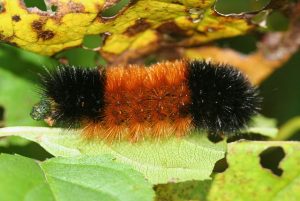What is it About Woolly Bears?
By Chris Williams on October 24, 2016.
Everybody loves the woolly bear, or wooly worm, or fuzzy bear. Whatever you call this fluffy-looking, rust and black caterpillar, it has a place in weather folklore. People believe, or pretend to believe, that the band pattern on a woolly bear can predict the severity of the coming winter. The wider the black bands on each end of the caterpillar, the colder and snowier the winter will be. Or conversely, the wider the rust band in the middle (and the smaller the black bands), the milder the winter will be.
What Kind of Insect is a Wooly Bear?

Folks think of the woolly bear as a creature unto itself because this is the only stage of its life cycle that we notice. Did you know that the woolly bear caterpillar is really the larval form of a moth, specifically a tiger moth? The most common species is the Isabella tiger moth that is rather attractive in its own right. Its wings are pale orange-yellow with dark speckles and span almost two inches.
We forget about woolly bears for most of the year. In fall, they become noticeable as they leave the weeds they have been feeding on and wander, looking for a place to spend the winter. We see them trucking along sidewalks or crossing roads, looking like insects on a mission. The prickly-looking hairs are not poisonous but handling a woolly bear can cause irritation in some individuals. Woolly bears easily survive even a frigid winter since their bodies contain a natural antifreeze. In fact, they have to freeze in order to complete their life cycle. In spring, the woolly bear thaws out, pupates, and turns into a moth.
Can a Woolly Bear Really Predict the Weather?
Sorry, but the banding on a single woolly bear doesn’t tell you anything about the coming winter. If you collect a bunch of woolly bears, you’ll see that they all have black and rust bands of different widths. Unfortunately, taking an average of the band widths on a bunch of woolly bears doesn’t tell you anything either. The fact is that woolly bears start out in life mostly black. They molt 6 times before turning into an adult moth and at each molt, the rust-colored band becomes a little wider. So, the older the caterpillar, the more rusty in color it will be. You can interpret that any way you want.
Photo Credit : By Andy Reago & Chrissy McClarren – Pyrrharctia isabella – Isabella Tiger Moth, CC BY 2.0, Link | By IronChris – Own work, CC BY-SA 3.0, Link